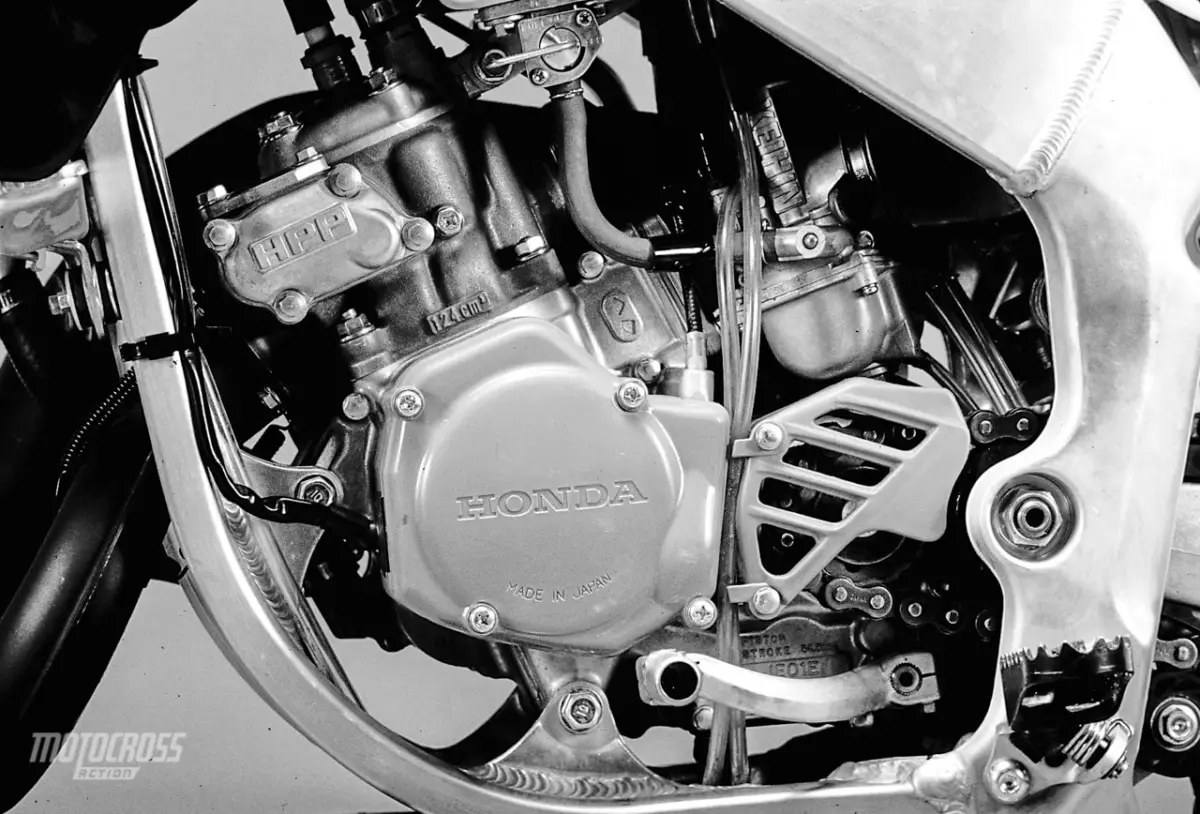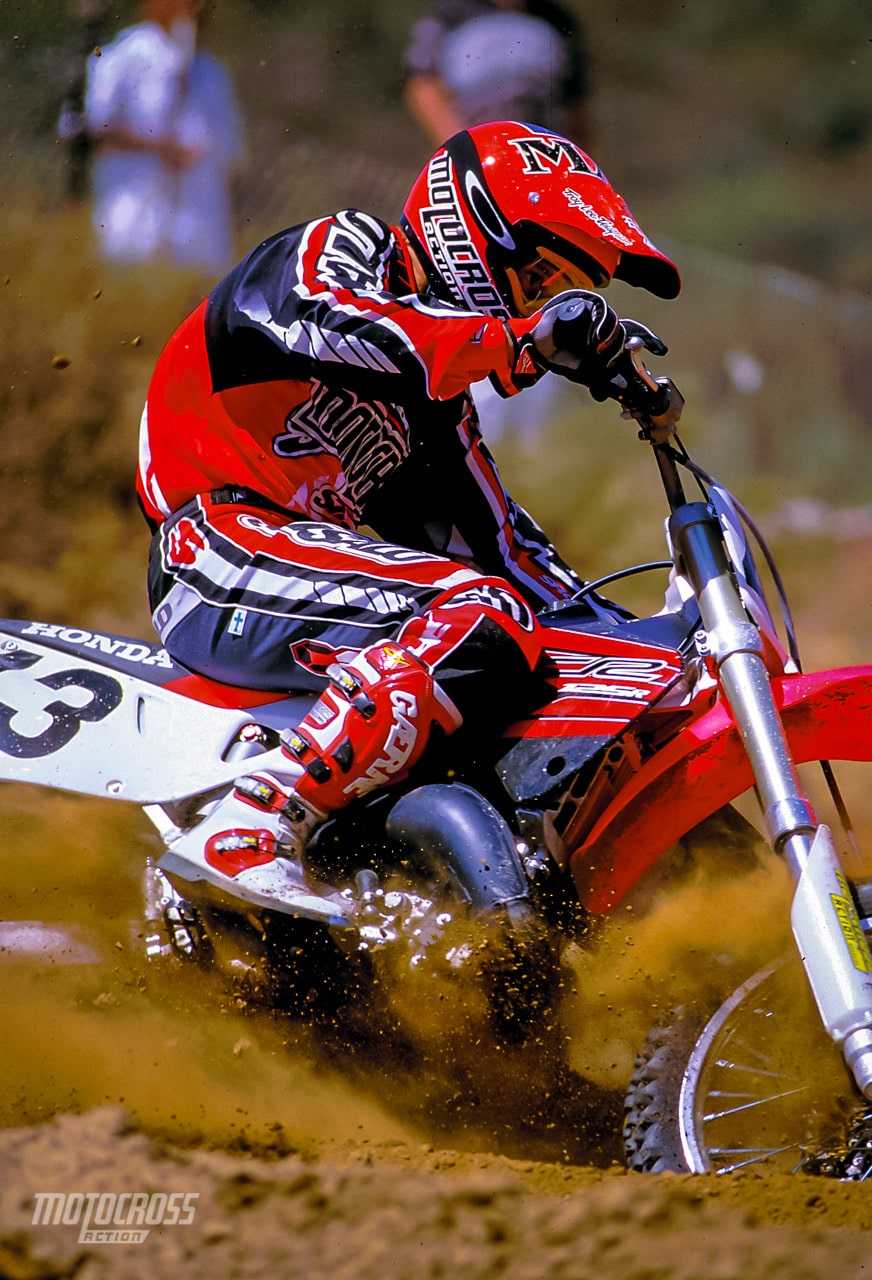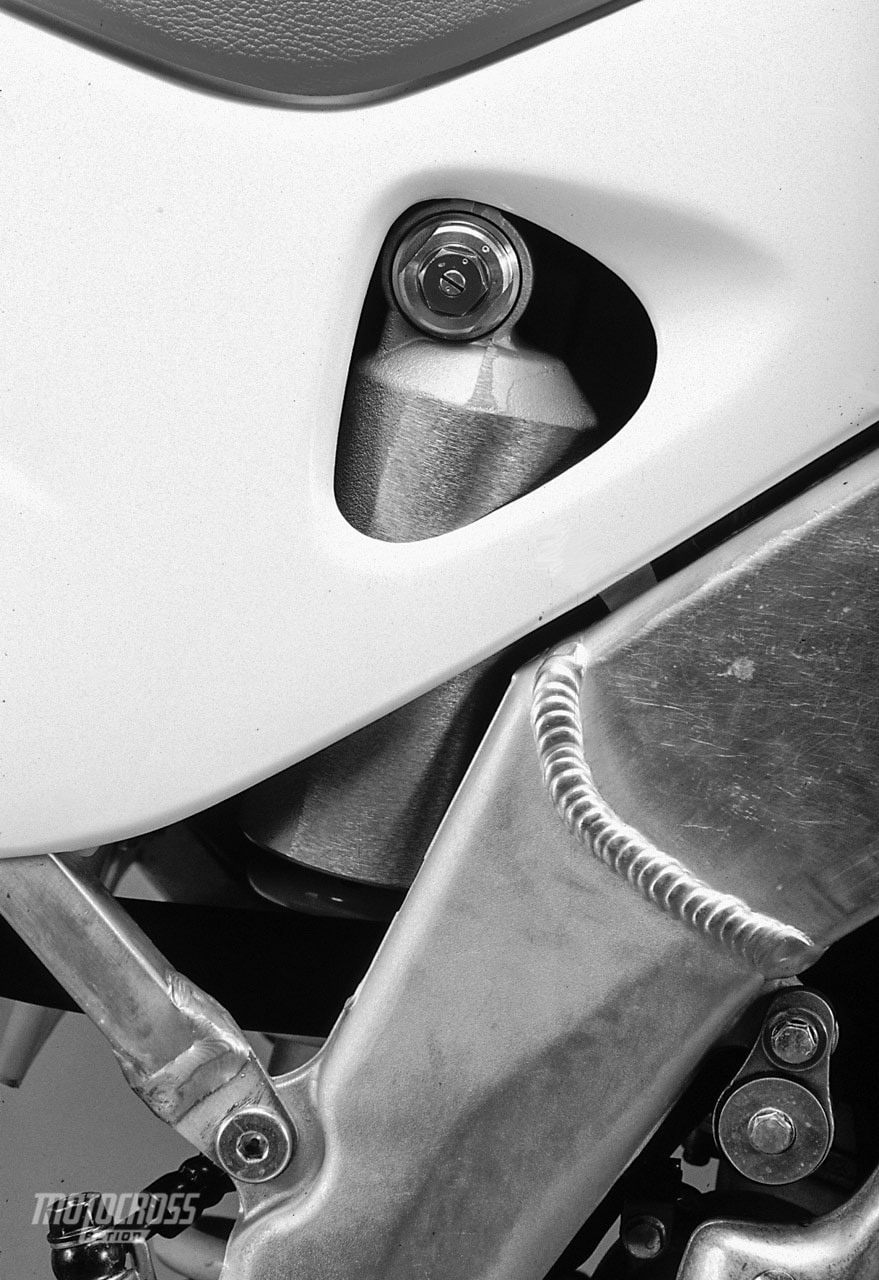MUST READ! COMPLETE TEST OF THE 1999 HONDA CR125
 This is a test of the 1999 Honda CR125 from the 1999 January issue of MXA.
This is a test of the 1999 Honda CR125 from the 1999 January issue of MXA.
QUESTION ONE: IS THE ’99 CR125 ENGINE FAST?
A: Honda has seriously mishandled the CR125 engine program. They went from awesome to mediocre in the span of three seasons. True, powerband tastes have changed, with the incredible YZ125 setting a standard for powerband width that no other manufacturer has been able to match, but that said, the CR125’s previous prowess was always in the upper ranges (from mid and up). That high rpm shriek has been lost to a host of unexpected spinoffs of the Delta Box frame (air boot crimping, airbox shape and pipe routing). For ’99 Honda hoped to, at the very least, regain what they lost in ’98. Is the ’99 CR125 engine fast? In a competitive world the answer to a closed-end question is often disappointing. While not slow, the CR125 doesn’t have the combination of breadth, ponies and duration to earn the accolade of “fast.”
Interested in buying a new 1999 Honda CR125? Here are a few facts:
Engine: Water-cooled, 125cc, two-stroke, reed-valved engine.
Bore and stroke: 54mm by 54.5mm
Transmission: Five-speed, wet clutch.
Suspension: 12.1-inch Kayaba 46mm upside-down forks and 12.6-inch Kayaba shock (with 20 rebound clicks and 18 compression clicks).
Wheelbase: 57.2 inches.
Claimed weight: 192.9 pounds.
Price: $4899.
 Honda has seriously mishandled the CR125 engine program. They went from awesome to mediocre in the span of three seasons.
Honda has seriously mishandled the CR125 engine program. They went from awesome to mediocre in the span of three seasons.
QUESTION TWO: WHAT DID HONDA CHANGE ON THE ’99 CR125 ENGINE?
A: Not enough! The ’99 Honda CR125 engine has seen better days. It’s an old design, with elements of the engine dating back to the Johnny O days, and it has been tweaked, fine-tuned and fiddled with to the nth degree. In the hands of the race team it can still rip, but off the assembly line it has limitations.
Honda seems to be aware of the performance boundaries of the engine castings, because they made very few changes to an engine that needed many. Here is the short list of what Honda’s engineers modified for ’99.
(1) Carbon fiber reed petals replace the epoxy petals of ’98. The snappier opening of carbon reeds normally improves mid and up power.
(2) Last year the CR125 suffered a plethora of jetting woes. Improved brass has been installed at the factory to try to bring the CR back up to snuff.
(3) The CPU in the ignition has been increased from 8-bit to 16-bit to provide better ignition timing for the 3-D map-type curve.
(4) Honda engineers beefed up the engine cases for more rigidity and durability.
(5) The front and lower engine mount bolts have been increased from 8mm to 10mm.
QUESTION THREE: IS THE CR125 FASTER THAN A YZ125?
A: This is the question that every inquiring 125 rider asks. The answer is no. Honda did not significantly improve the overall performance of the ’99 CR125. So how does the ’99 CR125 engine work?
(1) It has no bottom whatsoever. It’s dead down low, which means that tricky track situations (off-cambers, mud, trials sections and hard-pack) have to be negotiated by coasting. Rolling the throttle on does not reward the rider with ever increasing doses of power. The only way to get power out of the CR125 is to wick it on wide open.
(2) The midrange is where the CR125 does its best work. It is responsive, active, potent and promising. It is dead-center in the middle that the CR125 is at its most effective.
(3) The fabled top-end of a few years ago either isn’t all it was or wasn’t all it was cracked up to be in the days of light switch 125s. Even though the CR125’s top-end has some holes in it, you still have to rely on it to get from gear to gear on the five-speed tranny. However, test riders didn’t use rev to generate velocity, but rather to get the drivetrain lashing fast enough to give the midrange of the next gear a fighting chance.
(4) The MXA test crew may have painted too bleak a picture of the ’99 CR125 powerband. The engine can still win races. It has a distinct midrange hit and passable rev. If you hit each shift on the money, make the most of the middle, stay off the bottom, don’t depend too much on the slightly confused top-end and carry speed from gear to gear (with the tranny geared down) you can have good times on the CR.

The midrange is where the CR125 does its best work. It is responsive, active, potent and promising. It is dead-center in the middle that the CR125 is at its most effective.
QUESTION FOUR: WHAT ABOUT THE JETTING?
A: The MXA test crew races in a sea level paradise. (Okay, the typical SoCal track is above the mean high tide line, but not by much.) We tested several different jetting scenarios. The CR125 is very touchy. Get it wrong and the bike will not only be slow–but it might blow. Here is the best jetting for our conditions:
Mainjet: 175
Pilot jet: 55
Needle: 1368M
Slide: 5.0
Clip: groove number 3
Air screw: 2-1/2 turns
QUESTION FIVE: HOW GOOD ARE THE NEW KAYABA FORKS?
A: Unlike the CR250, which uses Showa suspension components, the CR125 comes with Kayaba bumper forks. In fact, they are almost the exact same forks that come stock on the YamahaYZ125. Don’t get too misty about that, though. The YZ125 has passable forks, but nothing to waste a stamp writing home about. Honda, by virtue of buying off-the-shelf Kayaba components, doesn’t have standout forks.
While the forks may be clones of the Yamaha forks, Honda did benefit from a few fork improvements: (1) Steering offset has been changed from 22mm to 24mm to improve straight line stability. (2) The fork spring rate has been increased from 0.39 to 0.41 kg/mm. (3) Travel has been increased by 2mm to 12.1 inches. (4) A redesigned piston-slide bushing provides smoother action, while the fork bumper gets a higher density elastomer to resist bottoming.
What was our best setting? For hardcore racing we recommend this set-up:
Spring rate: 0.41 kg/mm
Oil height: 135mm
Compression: 5 clicks out
Rebound: 12 clicks out
Fork leg height: flush with top of stanchion
Notes: The spring rate is spot on, but the valving leaves a little to be desired. Setting the compression to 12 results in a plush ride, but any bump bigger than a ripple will result in a melodic metal to metal clank.
QUESTION SIX: WHAT ABOUT THE REAR SUSPENSION?
A: Honda’s engineers have finally backed away from their insistence on 110mm of race sag. They got to those extremes by juggling the length of the shock to raise the rear of the chassis. Not surprisingly, they have returned to a standard 100mm of race sag by shortening the Kayaba shock’s overall length by 1mm. The 1mm shorter shock relaxes the head angle, increases trail and lowers the seat height (approximately 5mm). Additionally, the ’99 shock rides on a revised shock linkage, which is rated to improve low-speed absorption and offer a more compliant feel.
QUESTION SEVEN: WHAT WAS OUR SHOCK SET-UP?
A: What was our best setting? For hardcore racing we recommend this shock set-up:
Spring rate: 4.6 kg/mm
Race sag: 100mm
High compression: 1 turns out
Low compression: 8 clicks out
Rebound: 25 clicks out
Notes: Pay careful attention to the Kayaba shock’s rebound settings. This is a slow shock. If the bike kicks on braking bumps or rotates forward over kicker jumps, take more rebound out.
QUESTION 11: HOW DOES IT HANDLE?
A: Honda’s aluminum frame is cool looking, high-tech and shiny, but it vibrates like a dentist’s drill, makes regular maintenance a pain, spreads ugly black oxidize marks on the plastic and, at least in Honda’s hands, hasn’t shown a single advantage over its chromoly steel competitors.
If this was the best handling 125 on the track, every bike would have an aluminum frame. We wouldn’t stop babbling about it and there would be a waiting list to get a CR125 from your friendly local dealer. Unfortunately, the CR125 suffers from the same fore/aft balance problems as its big brother. To get the CR125 to do what you want it to do, you have to flatten it out. That means that the front and rear must be on the same frequency for low amplitude bumps. If one end is jacked up, too stiff, wallowing or misaligned, the CR’s rigidity magnifies the imbalance.
The good thing is that the CR125, thanks to lighter weight and less power, isn’t as sensitive as the CR250. We rate it as a good handling 125 (below the quick and agile RM125, stout and stable KX125 or workmanlike and foolproof YZ125).
 If this was the best handling 125 on the track, every 1999 bike would have an aluminum frame. We wouldn’t stop babbling about it and there would be a waiting list to get a CR125 from your friendly local dealer.
If this was the best handling 125 on the track, every 1999 bike would have an aluminum frame. We wouldn’t stop babbling about it and there would be a waiting list to get a CR125 from your friendly local dealer.
QUESTION 13: WHAT DID WE HATE?
A: The hate list:
(1) Vibration: Thanks to the rigid nature of the frame, test riders believed that they had to hold on tighter, soak up more vibration and strain their muscles to work the suspension.
(2) Shock adjustment: The best way to set the preload is to get someone else to do it for you. The shock is almost inaccessible.
(3) Drive chain: The stock chain is junk.
(4) Bars: Although the stock bend isn’t bad, the CR125 benefits from aluminum bars because they take some jolt out of the high amplitude bumps.
(5) Gearing: The ’99 falls on its face with the stock gearing. Put a 52 on in place of the stock 51.
(6) Shifting: We never thought that dropping sixth gear would make a bit of difference, but it does. The CR125 has always had excessive gaps between gears (ones that required teeth on the rear sprocket to narrow) but now it misses shifts way too often (or worse, sticks in third gear).
(7) Aluminum oxide: Aluminum oxide is stuff that your boot rubs off the aluminum spars and deposits on the side panels (in the form of dark smudges).
(8) Tank decals: The red and black motif is dark and moody and gets even more so as the graphics wear out.
QUESTION 14: WHAT DID WE LIKE?
A: The like list:
(1) Brakes. They are perfect.
(2) Clutch: Very durable.
(3) Grips: Very good.
(4) Seat bolts: Nice 12mm heads.
(5) Durability: Solid construction, good metallurgy, excellent reliability.
QUESTION 15: WHAT DO WE REALLY THINK?
A: Let’s review.
Engine: The powerband is on the short side. This would not be a crime if it weren’t for the YZ125’s broadness. As is, the KTM 125 is a better example of what the Honda should have been, while the RM and KX do as good a job in the middle.
Handling: The alloy frame requires the rider’s constant attention. The bike is busy with lots of fore/aft movement. We’d rate it mid-pack on the handling scale.
Suspension: The CR125 is a mixed bag of blues. The forks want to work, but the rear shock won’t let them. The end result is a bike with suspension that makes a deafening clank as it skips from one bump to another.
Overall rating: To tell the truth, if the CR125 was the fastest thing on knobbies, we could forgive (and live with) everything else about the 1999 model. But it isn’t, and we can’t.








Comments are closed.